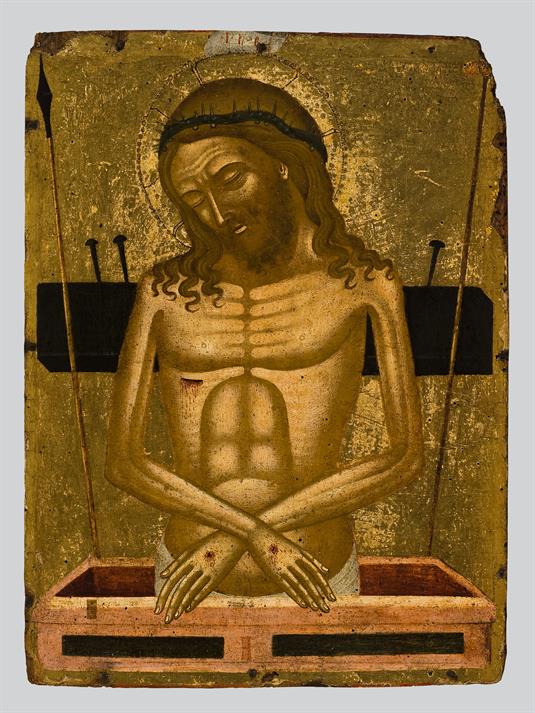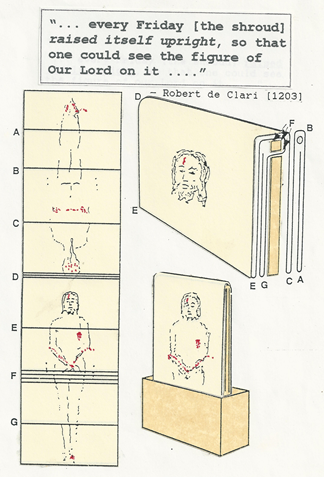A common motif, particularly in Byzantine and Medieval art, is the Man of Sorrows. It sometimes has Jesus in a “box”. This motif has been popular throughout history.

https://www.ebyzantinemuseum.gr/?i=bxm. … bit&id=214
This motif originated from the Byzantine Epitaphios which dates back to possibly 8th century.
The image developed from the Byzantine epitaphios image, which possibly dates back to the 8th century. A miraculous Byzantine mosaic icon of it is known as the Imago Pietatis or Christ of Pity. The work appears to have been brought to the major pilgrimage church of Santa Croce in Gerusalemme in Rome in the 12th century.
https://en.wikipedia.org/wiki/Man_of_Sorrows
https://www.metmuseum.org/art/collection/search/211510
The Eiptaphaios (“above the tomb”) is an icon on a large cloth with the image of Jesus on it.
The Epitaphios (Greek: Ἐπιτάφιος, epitáphios, or Ἐπιτάφιον, epitáphion, meaning “above the tomb”; Slavonic: Плащаница, plashchanitsa; Arabic: نعش, naash) is a Christian religious icon, typically consisting of a large, embroidered and often richly adorned cloth, bearing an image of the dead body of Christ, often accompanied by his mother and other figures, following the Gospel account. It is used during the liturgical services of Good Friday and Holy Saturday in the Eastern Orthodox and Byzantine Catholic churches, as well as some Oriental Orthodox Churches.[citation needed] It also exists in painted or mosaic form, on wall or panel.
https://en.wikipedia.org/wiki/Epitaphios_(liturgical)

https://www.wga.hu/html_m/c/ceccarel/sorrows.html
If the TS is authentic, all these motifs most likely then originated from the Holy Shroud.
The imagery of the Man of Sorrows began in 12th-century icons in the East, where it is thought to have been modeled on the Holy Shroud, which was on display in Constantinople until the sack of 1204.
https://www.christianiconography.info/e … rrows.html

https://commons.wikimedia.org/wiki/File … T11658.jpg
Textual evidence relate the shroud being raised.
Two other texts are suggestive in support of a gradual raising of a cloth bearing a
full-body image such as would underlie the ritual’s child-to-crucified changing display.
Nicholas Mesarites, in 1201 the overseer of the imperial relic treasury in Constantinople
and thus eyewitness, described the sindon in his care. “In this place the naked Lord
rises again [anistatai] and . . . the burial sindons can prove it [ekdelon].” 12 Two years
later, Crusader Robert of Clari reported: “In the church of Our Lady of Blachernae [the
Blachernae Palace being the more recent dwelling of the Byzantine emperors] the
sydoines [sic: singular] of Jesus stood up straight every Frida y [cascuns devenres se
drechoit tous drois] so that the figure of Our Lord could be plainly seen there.”
https://www.shroud.com/pdfs/n56part3.pdf
STURP team leader, John Jackson, theorized they had constructed a device in Constantinople to raise the cloth from a box to gradually reveal the body of Jesus.

Physicist John Jackson identified a number of crease lines on the Shroud (lettered A-G above) during the 1978 scientific investigations. He then built a “jack-in-the-box” mechanism winding the Shroud around wooden supports that would raise it from a box consistent with Wilson’s proposed “King of Glory” ceremony in Constantinople.More recently researchers at the Turin Shroud Center of Colorado have found physical evidence on the Shroud strongly supporting this reconstruction. Numerous old wrinkles dating to many hundreds of years ago are consistent with a folding arrangement wherein the cloth was wound around various wooden supports.
These researchers even have found tack holes pinning the cloth to those supports still visible in 1978 scientific photographs.
https://biblearchaeology.org/the-shroud … tantinople
https://debatingchristianity.com/forum/viewtopic.php?p=1121100#p1121100
